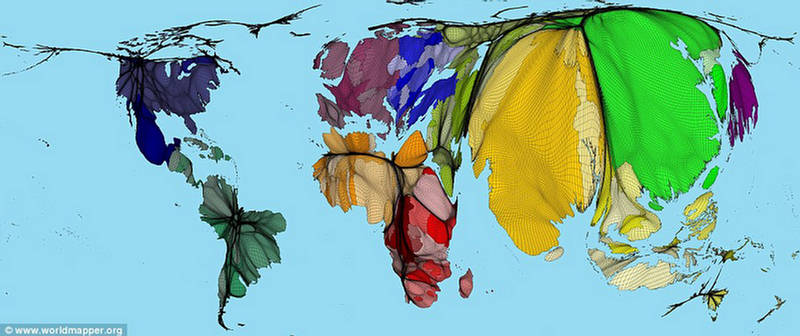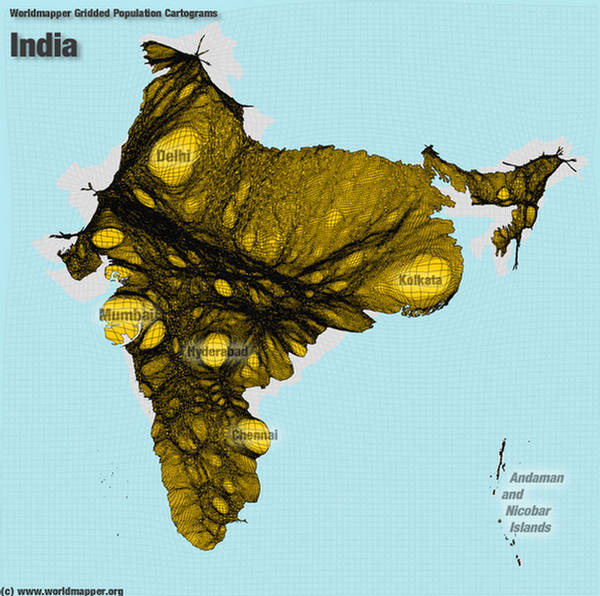A Yukaghir girl in love with a Yukaghir boy wrote him a letter. The Yukaghir are a North Eastern Siberian tribe who live by hunting and fishing. The letter is given below. This image constitutes the complete letter. Any guesses as to what it says?
A bit tough to understand, isn' t it? The first I came across this letter, I couldn't understand any of it; in fact I only saw it as a drawing. But it is a letter indeed and what follows below is the explanation. I have highlighted the parts using various colours and then broken down the sequence of events into 9 frames only to explain the chain of thought. The actual letter is just the one colourless image shown above.
1. The writer of the letter, the Yukaghir girl, is the tree shape in Blue. We know she is a girl because she has plaited hair.
2. The girl is in love with a Yukaghir boy, another tree shape, in Green. He is a boy as he doesn't have plaited hair. The letter is addressed to him.
3. The Yukaghir girl writes that she and the boy loved each other and this is depicted by the intermingling of their thoughts just above their tree point heads.
4. The girl further writes that now the boy has left her for another girl, a Russian girl and started living with this Russian girl. The Russian girl is shown to the left of the boy in Red and they are shown together living under one roof (a step pyramid/tent-like structure over their heads). The Russian are ethnically, socially and culturally completely different from the Yukaghir and the writer shows this by drawing panniers on the Russian girl's skirts (which are absent from her own Yukaghir skirt). The Russian girl of course also has plaited hair as she too, is a girl.
5. The Yukaghir girl tells the boy that the Russian girl has destroyed the relationship the Yukaghir boy and girl had earlier. This is depicted by the Russian girl's thoughts emanating from her head and cutting through the thoughts / love shared by the Yukaghir boy and girl earlier shown in figure 1.
6. However the girl knows that all is not well between the Yukaghir boy and his Russian girl friend. This tension is depicted by crosses between the heads of the Yukaghir boy and Russian girl, highlighted in Red.
7. The girl also informs the boy that she is alone in her house and she is sad. Her sad state of mind is shown by the crosses drawn behind her own head. But she tells him that she still often thinks about him and wants to be with him. Her thoughts (shown emanating from her head in Blue) are still.... sort of....drifting towards him.
8. However there has been a development. She tells the boy that now another Yukaghir boy has started making advances towards her. These are shown by a rather persistent and focused squiggly emanating out of this new boy's head towards the girl.
9. The girl finally lets her ex lover know that if he wants to get back with her he should move immediately, before she gives into the advances made by the new Yukaghir boy and before her ex lover has children with the Russian girl. Two children are shown on the extreme left moving into the house of the Russian girl and the Yukaghir boy.
And so this is the interpreation of this love letter written by a grieving Yukaghir girl to her ex lover.
Amazing isn't it. Suddenly the letter seems so clear after the explanation. This letter is an example of a
semasiographic system of writing. Semasiographic writing is when the writing/drawing represents the idea itself rather than any spoken words ie speech. The spoken words which are used everyday by the reader and the writer to communicate are not recorded in the written communication. The idea is recorded.
Actually we all deal with semasiographic writing everyday. Here are some examples:
Yup, these and many more semasiographic writings live all over our glottographic world. It is said that written mathematics is a very pure form of semasiographic writing.
Semasiographs are not the same as pictures. They are very much language based communication and are fluid in the sense that they can depict tenses and are very precise in interpretation to those who know how to read them, unlike pictures which are frozen and hence perhaps timeless and are also open to subjective interpretation. But most importantly any person using a
semasiographic system will have to represent the same idea in the same way. handwriting differences notwithstanding. Whereas in a picture, there are many different ways to drawing the same idea, eg. a woman sitting next to a tree. This can be drawn in many different highly divergent ways. But the Yukaghir people must write the letter above in the same way. Here in lies the greatest difference between semasiographs and pictures.
This is an example of a picture. Perhaps a grieving lover draws this picture and sends to the one she grieves for. Or perhaps not. She may just be sleeping next to a tree. It is a painting.
However this is clear written semasiographic communication. It's a letter, not a pciture. Those familiar with the Yukaghir language know how to read this letter. Every Yukaghir who wants to represent the idea of this letter in writing will have to write the same letter.
In both cases an idea is communicated. Both the painting and the semasiographic letter can be very precise if need be. But the two should not be confused.
Now the more prevalent writing system in today's world is not semasiographic but
glottographic.This blog post is in English, which is an example of a glottographic system of writing. In a glottographic system the idea is not directly recorded in the communication. The spoken words which represent the idea are directly recorded. The idea to be communicated is not directly shown. Rather the written "speech" has to be read and then the idea becomes apparent. The Yukaghir people have actually now adopted the Cyrillic / Russian script for their languages after the Russification of North Eastern Siberia. Hence the Yukaghir languages have moved from a semasiographic system to a glottographic system of writing.
Obviously both semasiographic and glottographic systems have their respective advantages and disadvantages. Road signs, washing instructions, mathematics all if translated into glottographic writing would become extremely cumbersome and unwieldy. I think I would use neither exclusively if I had a choice. Both could be used in combination or different ones for different languages. That would be fun. And terribly confusing perhaps.In both the semasiographic system and the glottographic system, the writing, the language and the idea are being coded seamlessly and continuously but in different ways.
I came across this Yukaghir letter in a fantastic book on scripts called
Writing Systems by Geoffery Sampson. It is a great book and I can re-read it many times. I recommend it to anyone who is interested in scripts and perhaps also in linguistics. Most of the ideas for this blog post have come to me directly from the 2nd chapter of this book. I think I love scripts even more than I love languages. I wished to write a much longer post but I am sure it too would have joined my list of long dead unfinished posts. Perhaps one day I will write on the symbiotic world of scripts and languages as well. God willing.
Know More:
Writing Systems by Geoffery Sampson
The Yukaghir
A study of writing by Ignace Gelb
Russification




























